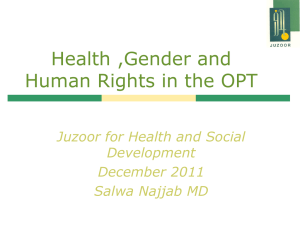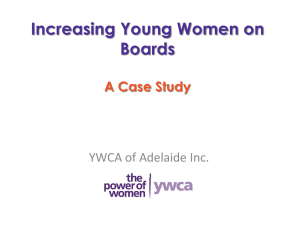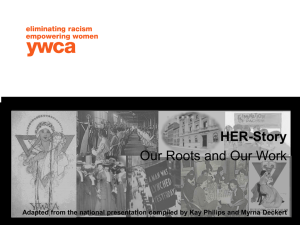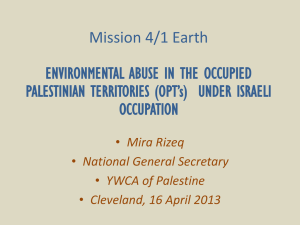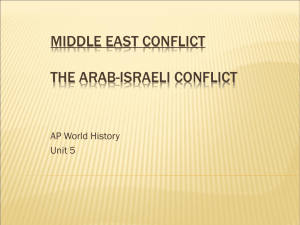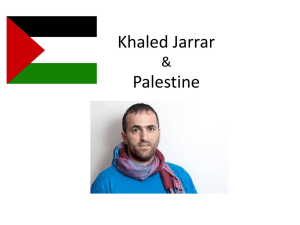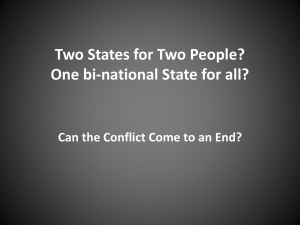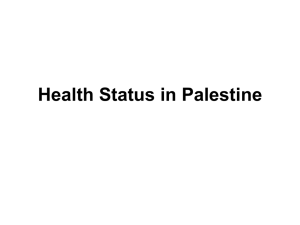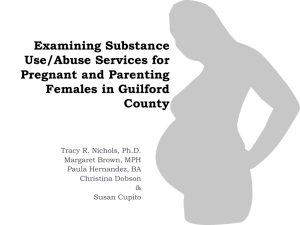YWCA of Palestine
advertisement
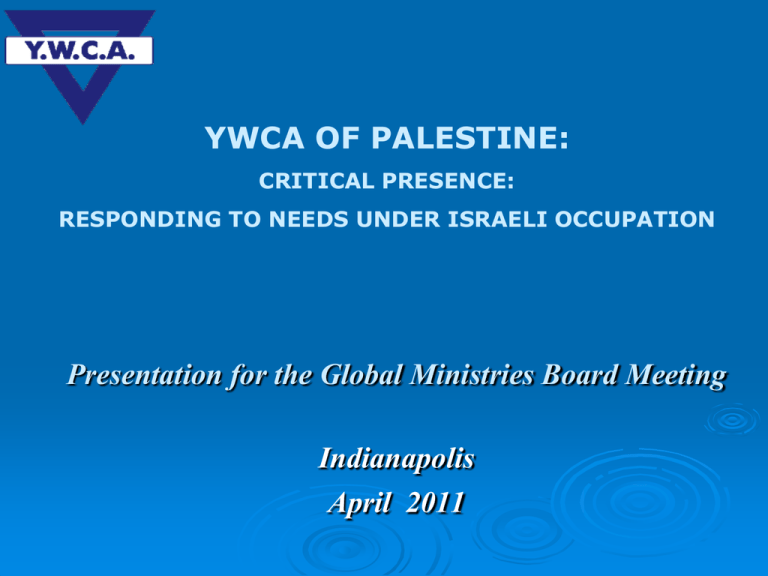
YWCA OF PALESTINE: CRITICAL PRESENCE: RESPONDING TO NEEDS UNDER ISRAELI OCCUPATION Presentation for the Global Ministries Board Meeting Indianapolis April 2011 FROM 1948 TO 1995 AND BEYOND Population and Distribution In 2010, the total Palestinian population worldwide has been estimated to be 10.9 million Living in the West Bank and Gaza Strip (WB/GS) is 4.3 million (2.5 in WB and 1.8 in Gaza), 44.5% of which are refugees The projected Palestinian population in WB/GS is estimated to be 5.1 million in 2015; Annual growth is 2.6% Christians Constitute 1.37% of the total population (Passia 2011) The population density in Gaza is 4,206 per sq. Km; the highest in the world, and 444 in WB (Passia 2011) The Palestinian Refugees: An Unsettled Dilemma Palestinians became refugees as the result of two wars between Israel and Palestine/Arab States: Al Naqba of 1948 Al Naksa of 1967 In 1948, 726,000 Palestinian became refugees, and over 1 million were displaced in the WB/GS after the 1967 war. (PLO Negotiations Affairs Department, Fact Sheet on Palestinian Refugees, May 2003) Today, the Palestinian refugee population is estimated at 7.1 million (67% of the total Palestinian population worldwide) Presently, more than 50% of Palestinians live in the Diaspora, and Israel continues to deny them their “Right of Return” Source: PASSIA, The Palestinian Academic Society for the Study of International Affairs- Jerusalem- Al Quds, 2006 Source: itISapartheid.org Israeli Official Policy and Practices: “Land without the People” Before the 1948 War, Palestinians owned 87.5% of the total area of Palestine. After the 1948 war, the West Bank became part of Jordan, and Gaza part of Egypt. Since 1967, the Israeli Occupation expropriated 79% of WBGS territory (44% for military use, 20% for security reasons, 12% for public use) Presently, over 85% of the Palestinian Land is still under the Control of Israel: there are 145 settlements in WBGS, incl. 26 in East Jerusalem In 2011, settlers in West Bank and Gaza are estimated to be 517,774 Home Demolitions for Palestinians: There are three types of demolitions practiced in WB/GS: Punitive Administrative (lack of housing permits) Land clearing operations/military demolitions Since 1967, 24,145 Palestinian houses have been demolished in WB/GS (ICAHD: Israeli Committee Against House Demolitions) Home Demolitions for Palestinian families are particularly devastating for women and children; physically, emotionally and psychologically After Oslo: Fragmentation of West Bank/Gaza: Area A: Full Palestinian Control (2% of WBGS) Area B: Palestinian Civil and Israeli security control (26%) Area C: Full Israeli control (72%), which holds 63% of Agricultural Land This zoning limits the possibility of construction and expansion as well as denies citizens access for services The Administrative Dimension: Permits are required for people to move from the West Bank to East Jerusalem, and across West Bank cities and villages Palestinians should acquire permits to move outside of their municipal boundaries All WB/GS citizens cannot access East Jerusalem, cannot drive on bypass roads, or cross entry terminals to East Jerusalem by car. A “normal” day in Palestine that depicts mobility restrictions. Photo Courtesy by Photographer Ahmad Daghlas Dimensions of Mobility Restrictions: The Physical Dimension: The Separation Wall, checkpoints, roadblocks, trenches, earth mounds, barriers and bypass roads. There are 62 permanent checkpoints dividing the WB. In 2008, physical obstacles were estimated at 600 (Source: World Bank- permanent checkpoints and barriers) 8% of West Bank land is estimated to have been expropriated for construction of bypass roads (for settlers). Palestinians living in the West Bank cannot use these roads. In 2010, $2.4 billion was injected in foreign Aid for Palestine, but due to closures and restrictions, impact on economic growth is marginal THE SEPARATION WALL Mobility Restrictions: The Separation Wall Basic Facts: Construction began in June 2002 by the Israeli Government Total expected length of the Wall is 725 km long built across entire the West Bank (90 km is in Jerusalem) The Wall has about 60 gates; twothirds built exclusively for settlers 12 official gates in Jerusalem, only 4 are open to Palestinians. The rest are for Israeli settlers Palestinians must obtain permits to pass through gates IMPLICATIONS ON ECONOMY AND LIVELIHOODS In 2000, poverty in Gaza was estimated at 33%, increasing to 52% in 2008. If remittances and food aid are deducted, then poverty will soar to 79% in GS and 46% in WB Unemployment in WB has risen from 11.5% in 1998 to 19% in 2008, and from 20.9% in Gaza to 40.6% for the same years Female labor force participation in WB/GS is 16%, amongst the lowest in the world: employment opportunities are restricted to a narrow range of fields: stereotyping of women labor (1) (World Bank Report: Checkpoints and Barriers: Searching for Livelihoods in WB/GS – Gender Dimensions of Economic Collapse, 2009/2010) (Gender based-violence in Palestinian Territory- Case Study- UNFPA- 2005) IMPLICATIONS ON EDUCATION • • • • • Students’ and teachers’ movement has become difficult, exhausting and energy draining West Bank teachers cannot teach in Jerusalem, putting pressure on teachers to work in more than one school (affecting quality of education) Due to deficit in PA budget, investments in education are decreasing Children are forced to pass through the Wall’s gates and face all kinds of physical harassment A big number of girls drop out especially in secondary education because they have to cross checkpoints or go to city and feel at risk. (Education under Occupation by UNESCO (PWR&DC) IMPLICATIONS ON WOMEN’S SAFETY The apparatus of movement restrictions is not gender blind, but it affects men and women in different ways. Women have been more vulnerable on checkpoints: uncertainty of safe passage, possibility of delays, and threat of intrusive body searches and detainment End Result: Women are afraid to cross checkpoints Women are subjected to violence and abuse. IMPLICATIONS ON WOMEN’S SAFETY While men are direct recipients of violence, women have to bear with its indirect costs: shouldering the family, running the household in men’s absence and working as a breadwinner. Many are not prepared for that role. During siege, closures, high levels of unemployment, poverty and isolation, there is more outward expressions of anger, with women and children being the most common targets and victims End result: Domestic Violence against women and children increasing Feeling of Humiliation and indignation Access to services is diminishing Militarization and Women’s Safety Study Sponsored by YWCA Military Occupation, Trauma and the Violence of Exclusion: Trapped Bodies and Lives By Dr. Nadera Shalhoub-Kevorkian One woman says: “I have no passport, I exist nowhere, the world does not recognize my nationality, I am unable to travel or move freely, wherever I go I need a permit or travel document from the Occupying Forces, I have no health insurance, if I get sick I cannot even afford to go to hospital, I wish I will die, and when I do, no one will miss me, we are like insects, human insects.” Another woman who lives in the Old City of Jerusalem said: “I hate living in the Old city, when I come back home at night, the soldiers always search me at Damascus gate, and check my address, I feel like I am in an airport, they always make fun of me, and once the women soldiers wanted to do a body search in the street, and when I refused to take off my clothes they kept me standing in the cold for hours. I am always afraid because there are no lights in the street and they can do anything …, how can I feel safe out of home” WOMEN’S SOCIAL SPACE AND ACCESS TO SERVICES Society at large, neighborhoods, and families have been fragmented with the construction of the Wall and barriers Women are losing their social networks and family support Women are unable to access educational facilities and places of work 38% of Palestinian mothers reported increased difficulties in gaining access to health services Since the second uprising (Intifada), more than 69 Palestinian women gave birth at checkpoints, due to delays or prohibition on travel to medical facilities (many stillborns) YWCA of Palestine: Our Response to the Situation Women’s groups under the name of YWCA started as early as 1893 Officially, the YWCA was founded in Jerusalem in 1918 In Love We Serve One Another Our Motto : “Let Us Keep Hope Alive” We stand for: Y: the young and the youth, and our mission is to give them hope W: is for the women, who are our constituency, and is who we are C: is for our Christian identity, values and ethos A: we are a membership based association of women YWCA on the Map National Office- Jerusalem Associations: Jerusalem, Ramallah &Jericho Refugee Camp Centers: Jalazoune/Ramallah Aqabet Jaber/Jericho Identity and Profile The YWCA of Palestine derives its values from its Christian basis. It is : A member in ECOSOC (UN) A membership-based Christian / women organization: have 300 local members registered locally as a non-governmental non-profit association (In Israel and Palestine) affiliated with the World YWCA movement (which operates in 125 countries) has over 25 million members globally The Vision of the YWCA The YWCA of Palestine envisions an independent and free Palestinian democratic state Works for: justice, peace, tolerance, equality, respect for the rights and dignity of human beings, gender equity, Promotes: women’s leadership The YWCA of Palestine… supports and aspires to create women leadership especially among young Christian women and girls, to realize their full rights and capabilities, and promotes full participation of women in decision-making on equal footing with men in all aspects of life, represents the aspirations of the most excluded women so we can build a democratic and free civil society that nurtures equality, diversity and respect to all Governance Body- YWCA of Palestine National General Assembly (27) Committees (constitution) Elections, Fundraising, Advocacy, internal audit) National Board 12 members: 3 Jerusalem YWCA 3 Ramallah YWCA , 3 Jericho YWCA, 1 President of National Board, 2 Vice Presidents, National General Secretary (ex-officio) Local Board Local Board Local Board Ramallah Jerusalem Jericho (7-9) YWCA of Ramallah 4/8/2015 (7-9) YWCA of Jerusalem (7-9) YWCA of Jericho 28 Physical Presence Three Local Associations: Jerusalem, Ramallah, Jericho One National Association: made up of local associations One mission, vision and strategic plan Each association has its own programs YWCA also operates two refugee Camp Community Centers: Aqbet Jaber near Jericho, and Jalazoune near Ramallah YWCA of Palestine: Local Programs The YWCA major services: Offers Vocational and Skills Training Education for women Offer Psychological counseling for women, especially traumatized women Offer employment opportunities in production projects in Jericho and Jalazoune refugee camp Promote awareness campaigns on women’s rights in all its localities Offer leadership training for young women and men, as well as opportunities for international exchanges and internships in/with YWCA’s globally Run two Kindergartens, educational and play centers in refugee camps Offer youth and children summer camps OUR STRATEGIC OBJECTIVES 1. Economic Empowerment of Women 2. Raising Awareness on rights and issues 3. Leadership Training and Civic Engagement for Youth 4. Cognitive learning for Children YWCA’s Program Thematic Areas 1. Women’s Economic Development • Vocational training programs • Employment generation porgrams 2. Promoting Women and Gender Rights • Training for Women on their economic, social and economic and health rights, incl. reproductive rights (HIV Education) •Join coalitions that work on violence against women (incl. honor killings) •3. Youth Leadership Training and Civic Engagement Training Workshops Voluntary Camps Youth International Exchanges 4. Children Education and Cognitive Learning Preschools in Refugee Camps Children After school centers and play centers Keeping Hope Alive Advocacy for Peace with Justice: On the Local level The YWCA seeks to promote awareness and educate the global movement, churches, international communities on the situation in Palestine, especially on and how it affects women and children. To do so, YWCA: - - - Conducts research on militarization, violence and women Issues Position Papers, Action Alerts Creates global solidarity for Peace with Justice in Palestine with global partners Organizes witness visits, advocacy visits, speaking tours for Palestinian women Works with other Christian organizations to support Christian presence and witness YWCA’s Global Response to the Situation World YWCA Council Meeting in Nairobi in 2007 renewed its commitment to Peace and Justice: issued a Resolution calling for “Peace, Security and Dignity for Women” in the Middle East” The members also endorsed the Action Plan for the Resolution which calls for: a. Educating membership on the situation of women in Palestine and the Middle East b. Supporting YWCA Programs in the region, including direct services, counseling, and education c. Implementation of UN SR 1325 (which calls for women’s Involvement in eh peace process) World YWCA established the Peace with Justice Task Force External Challenges for the YWCA The Israeli Occupation and all its implications: Compliance to Israeli tax regulations but no benefits Mobility restriction of staff and volunteers and limited access to sites Economic deterioration, increasing poverty and unemployment and continued pressure to do more Communities’ inability to cover cost of services Sustaining the Christian Basis of the Organization in light of a shrinking Christian presence Sustaining the spirit of voluntarism and giving in times of hopelessness 4/8/2015 39 External Challenges for the YWCA Staying responsive in a situation of conflict Sustaining itself as a youth movement when the young are not interested or attracted Being able to promote its Christian values through service and critical presence Shrinking financial resources because of donor’s policies in Palestine AS CHRISTIAN WOMEN… OUR MISSION IS TO KEEP HOPE ALIVE
